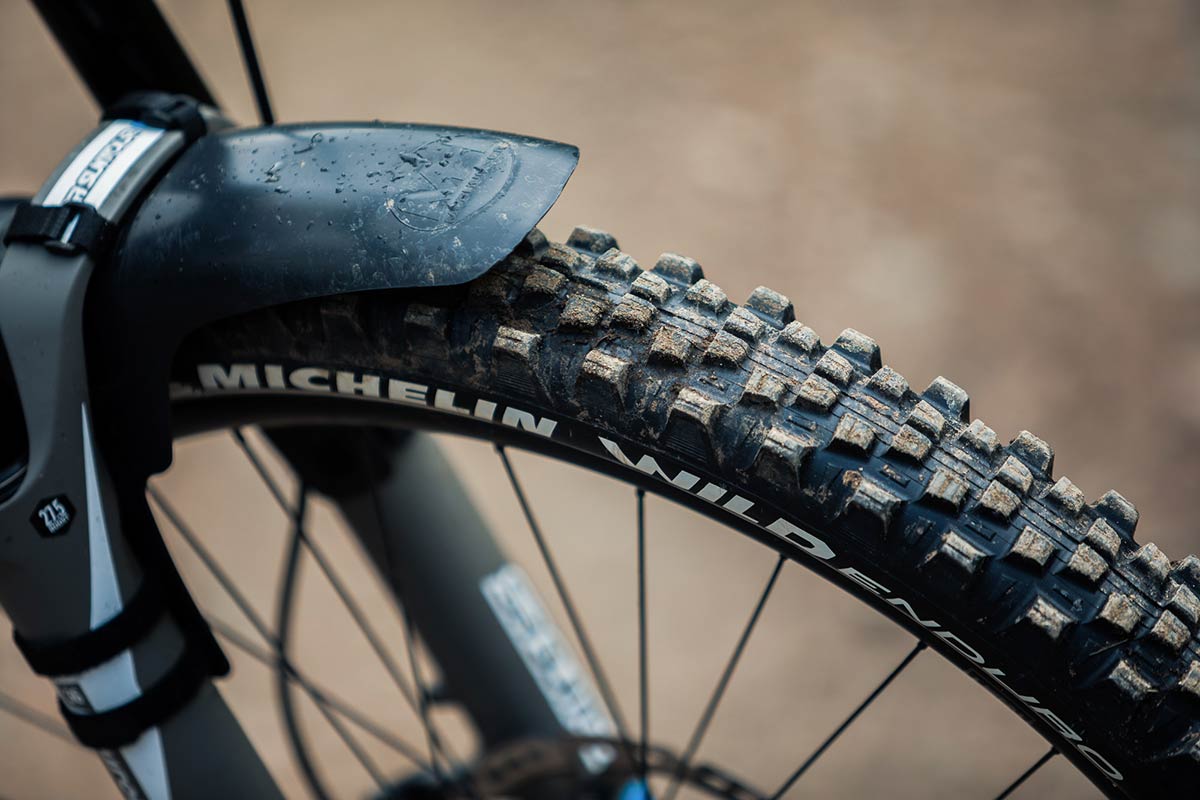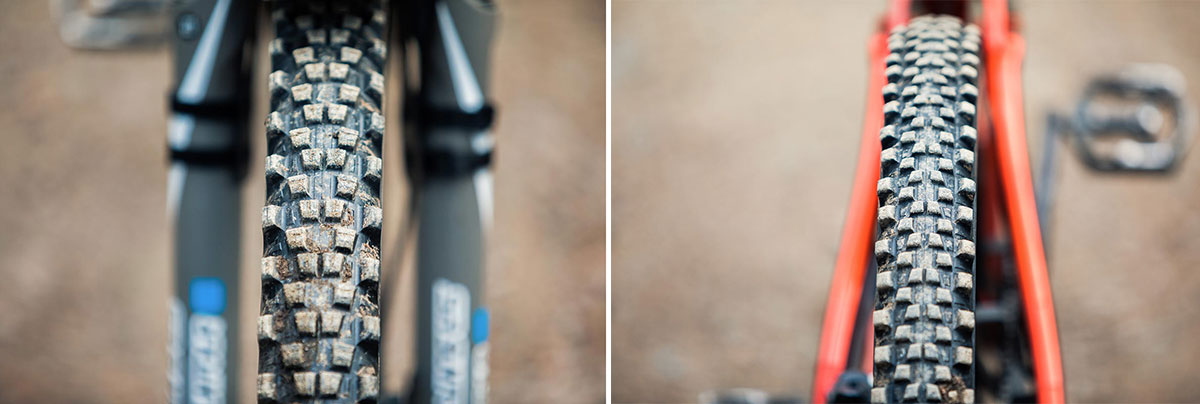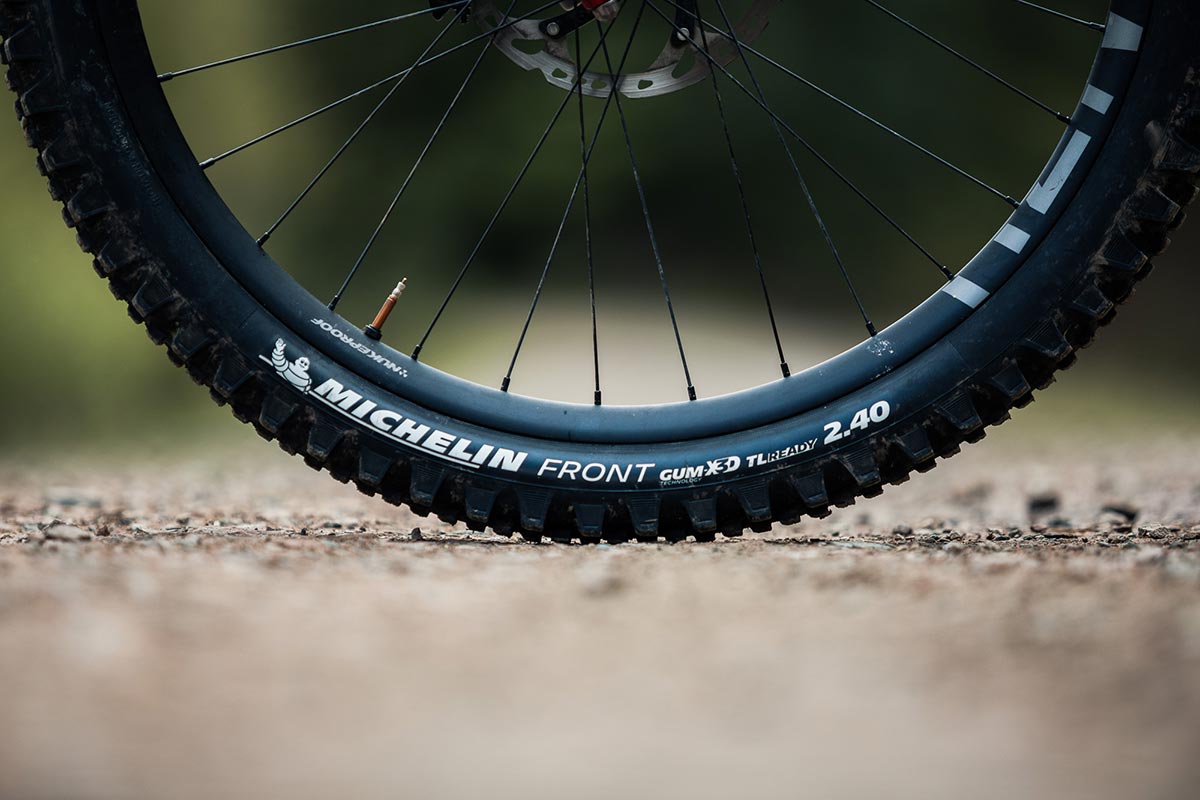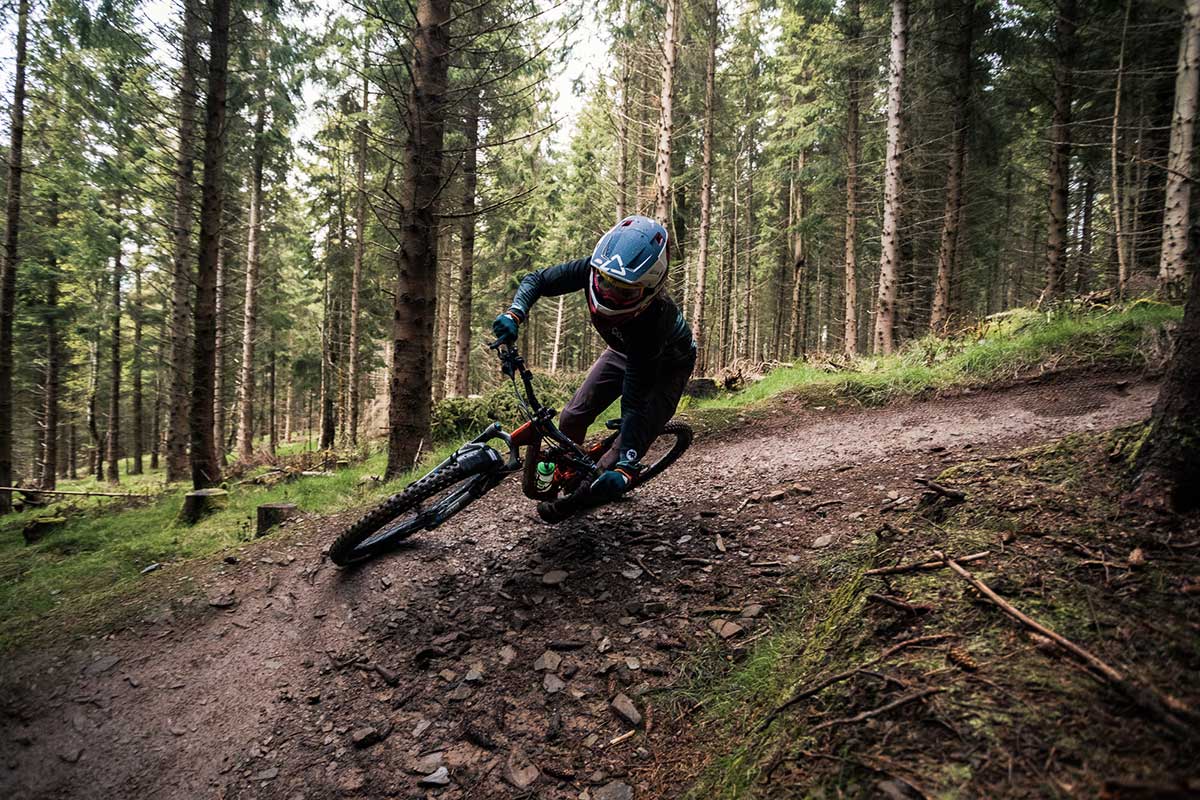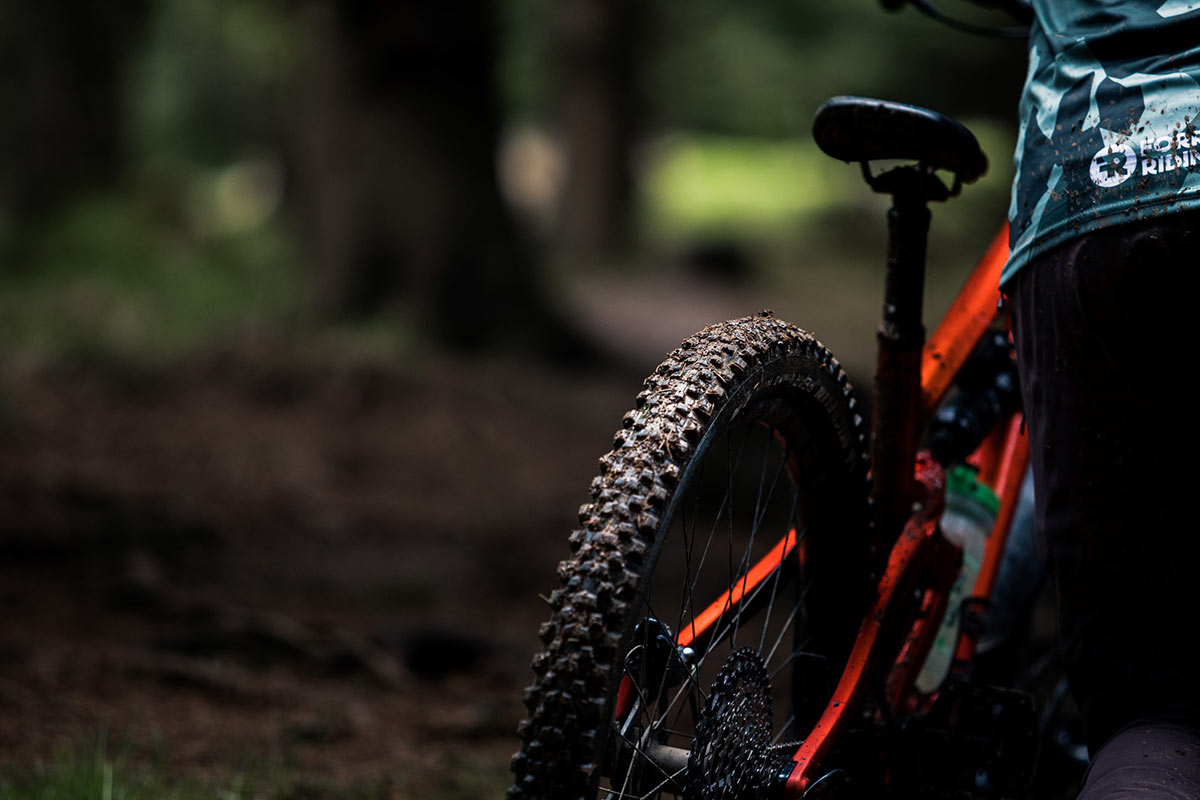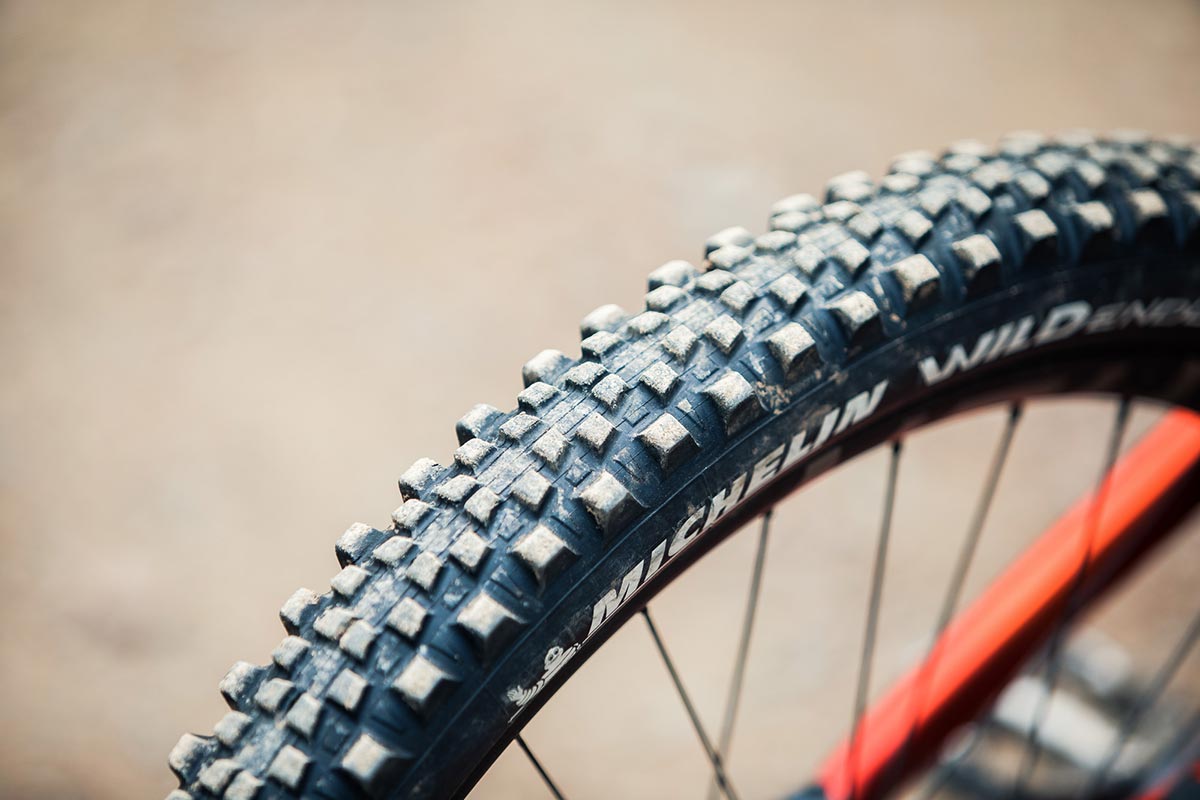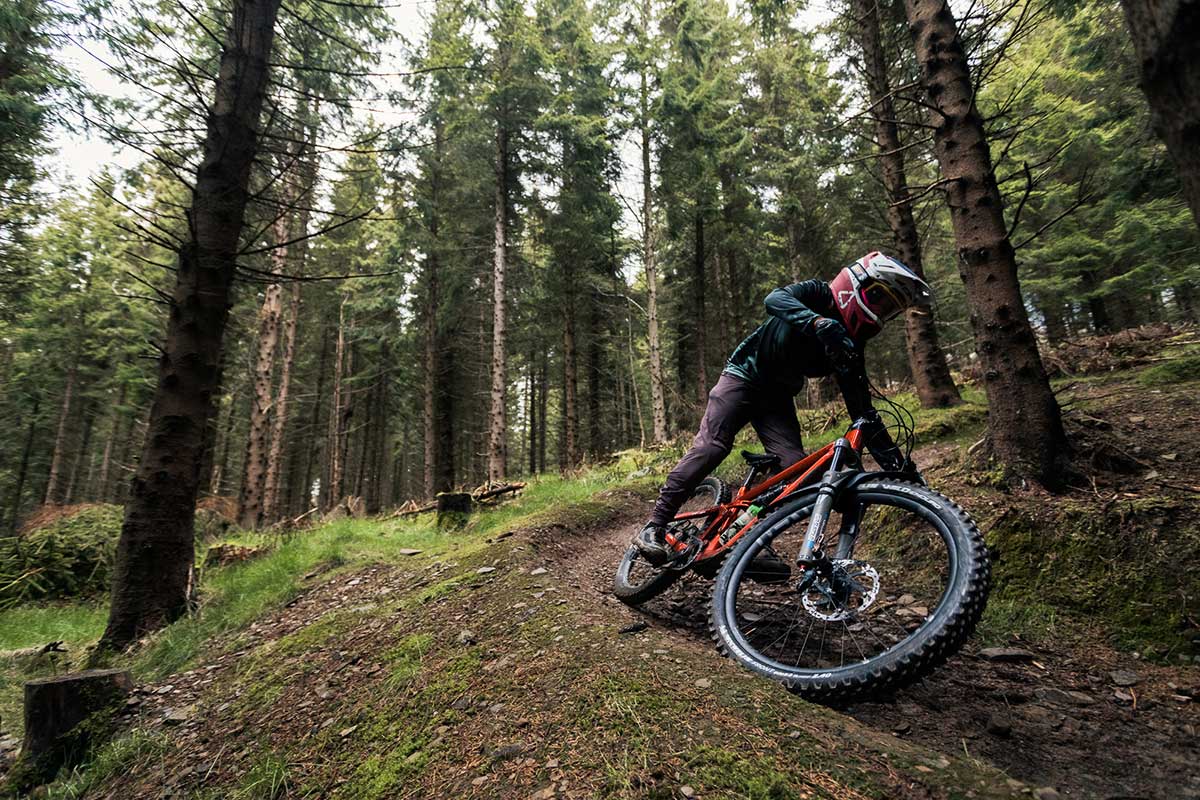Fitted to a Nukeproof Horizon V2 wheelset, we’ve been testing the Michelin Wild Enduro Front and Rear Tires. To a rider who spends almost all their time cutting about in winter-like conditions on steep, loamy hillsides, the two very different tread patterns of the Front and Rear tires initially seemed an odd pairing to me; the Front is very open and aggressive with large cornering lugs, while the rear is lower in profile with smaller lugs. That said, we did also get some dry, loose trail conditions during our time testing the Michelin Wild Enduro tires. Here’s our report.
Review: Michelin Wild Enduro Front & Rear Tires
Hands On
I tested the Michelin Wild Enduro Front 2.4″ Tire with the GUM-X3D Compound, paired with the Michelin Wild Enduro Rear Tire, also 2.4″ wide with GUM-X3D. This is Michelin’s softer rubber compound, with a harder MAGI-X “race” compound available for the Front tire only.
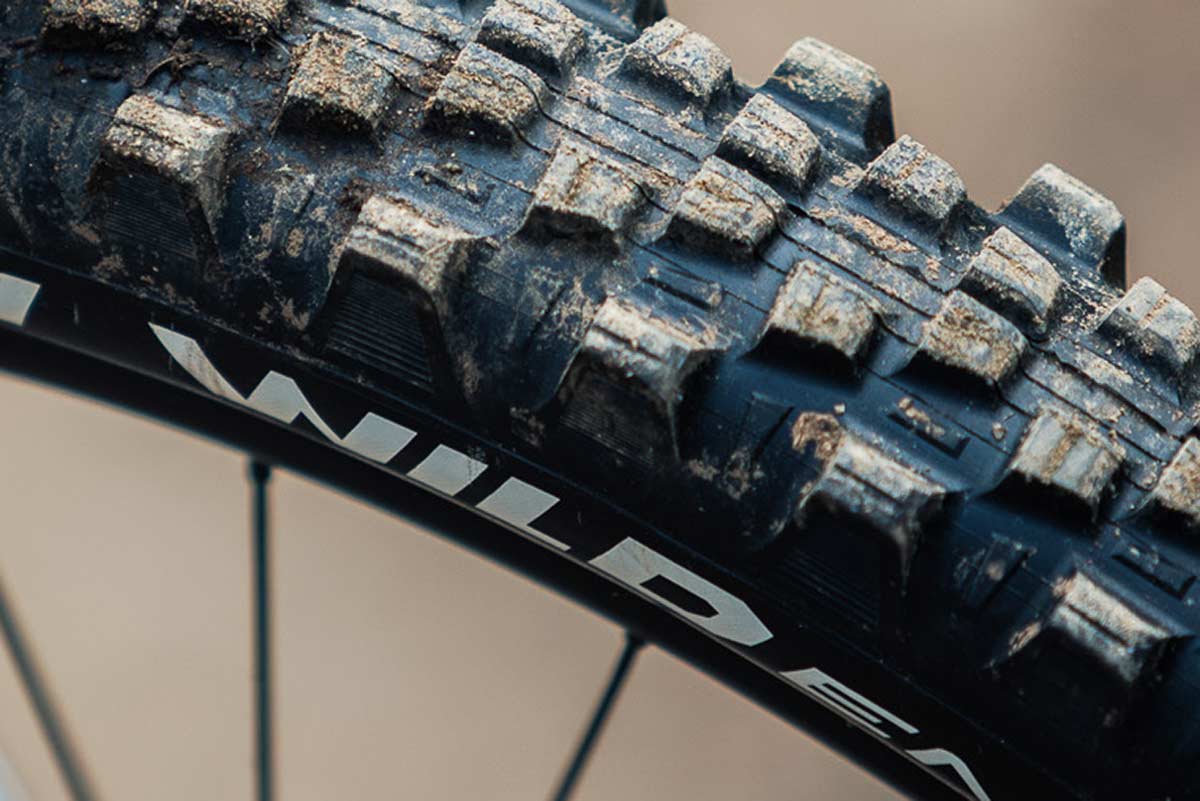
To touch, the GUM-X3D lugs are fairly firm – a huge amount firmer than the lugs of a MaxxGrip Assegai, and less so but still significantly firmer than the lugs of the MaxxTerra DHRII tire (I use these for comparison as I have them immediately to hand). The cornering lugs aren’t super stiff, though. There is some flex, which is more evident on the larger lugs of the front tire which feature a sipe that runs in the direction of travel.
Seated on the 30mm internal width aluminium rims of the 27.5″ Nukeproof Horizon V2 wheelset, I rode the original, lighter casing tires. Also available (only in 29″) are the newer 4-Ply Racing Line tires with bead-to-bead protection, which are more appropriate for higher speed downhill racing. Our set of tires lose the 4-ply casing at the sidewalls, but that doesn’t mean they’re flimsy by any means.
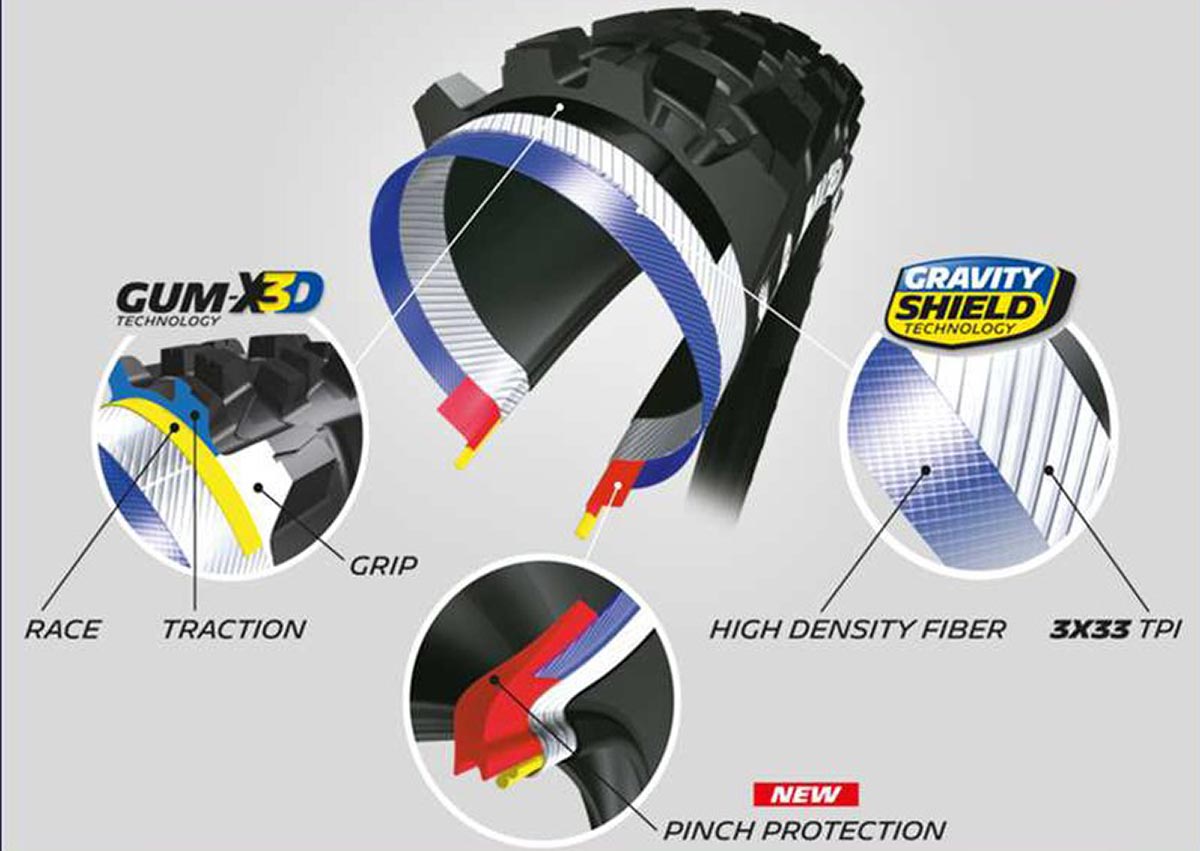 They still get a layer of high-density fibre stretching from bead-to-bead; Michelin’s Gravity Shield Technology put in place to prevent sidewall cuts. There’s also a layer of reinforced material that extends out from the bead, designed to prevent pinch flats.
They still get a layer of high-density fibre stretching from bead-to-bead; Michelin’s Gravity Shield Technology put in place to prevent sidewall cuts. There’s also a layer of reinforced material that extends out from the bead, designed to prevent pinch flats.
Riding the Michelin Wild Enduro Front
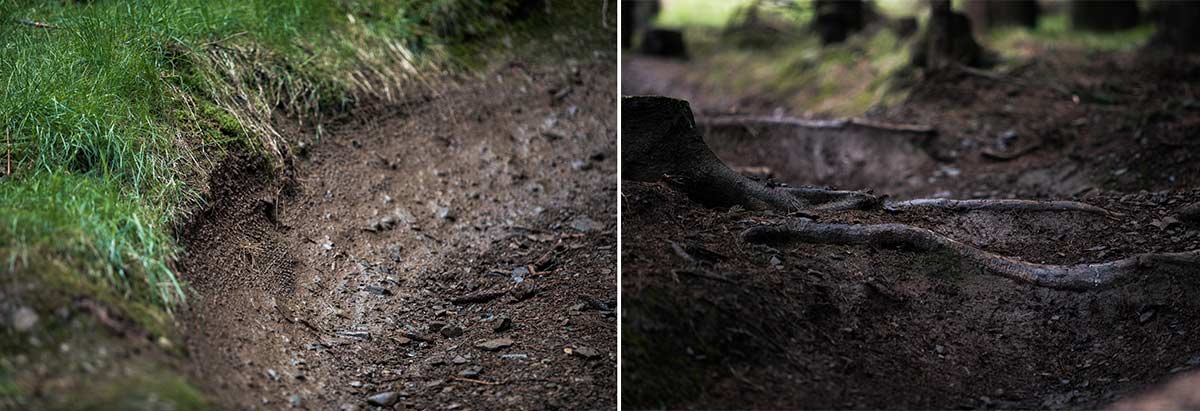
My first few rides on this tire were wet and sloppy, on the steep, soft, slippery, sometimes off camber, muddy corners the Tweed Valley is famous for. A great test for the open and aggressive tread pattern of the Michelin Wild Enduro Front Tire. It is in these conditions where the tire excels, delivering unprecedented levels of cornering grip. As you put the tire on its edge, you can feel, and hear, the side knobs cut through the soft, top layer of greasy loam, biting the firmer terrain sitting just below the surface.
I’ve had some really great rides on this tire, and I put that down to the confidence it gives me in wet and wintery trail conditions. The tire comes alive on off camber loamy sections too, with the big firm lugs digging into the top soil and holding the line without drama.
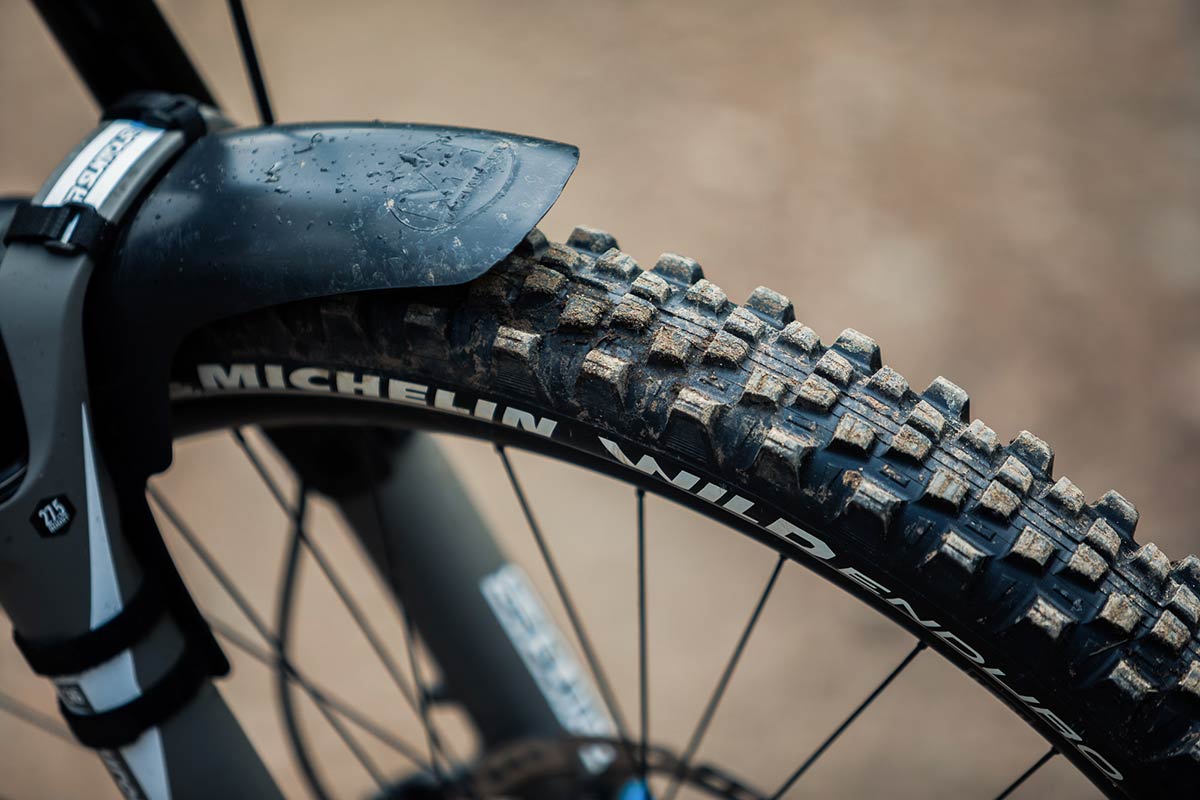
I didn’t feel quite the same level of cornering grip, and thus confidence, riding this tire in dry, hard-pack and loose conditions. For me, the relatively firm cornering lugs don’t offer quite enough flex to be forgiving when you lean the bike over too far, or, let’s face it, with insufficient angulation technique. The grip is great and reliable up and to a point, until all of a sudden it is gone entirely; what I mean to say is, there’s very little warning that you’re approaching the edge of your grip, thus not much time to correct before the front wheel washes out.
Conclusion: The Michelin Wild Enduro GUM-X3D is a great tire for winter riding in the UK, offering often unfathomable levels of cornering grip in the sloppiest trail conditions. Bite is excellent under braking.
Riding the Michelin Wild Enduro Rear
The tread pattern of the Wild Enduro Rear, and my riding impressions of it thus far, leave me a little confused as to what the designers were going for with this pairing. While the Front and Rear tires are very good in their own right, for me at least, they don’t seem to complement each other on the trail.
Let’s be clear; wet weather riding is what I am most familiar and comfortable with, hence my delight at how well the Wild Enduro Front tire performs in soft, muddy conditions. I have to say, however, that the Rear tire is a little disappointing in those same conditions. While the Front tire is working hard cutting through mud and biting the terrain for front wheel grip in corners, the rear tire is having an absolute party out back.
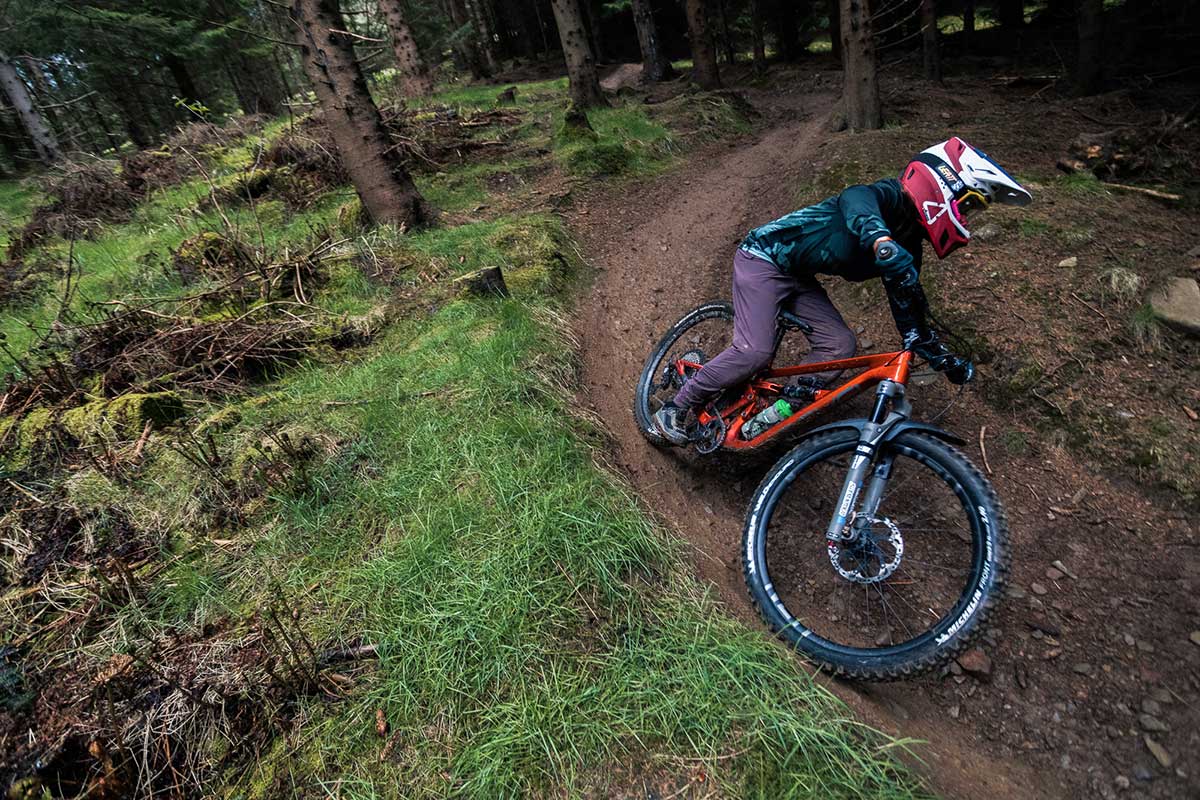
And by party, I mean fish tailing. The smaller, lower profile centre-tread blocks and smaller cornering lugs do leave a lot to be desired on softer, wet terrain, to the point where they are often unable to cut through deep enough to find purchase, leaving the rear wheel sliding about, wildly. Don’t get me wrong, it’s a hell of a lot of fun, but may not give you that super clean, precise run you’re after.
It’s on dry hard pack trails where the Michelin Wild Enduro Rear Tire excels. The lower profile knobs result in a tire that actually feels pretty fast rolling. It provides sufficient grip under braking, without being so burly that you can’t make it slide a little when the trail demands it. I’m not talking about radical shralping (that particular skill isn’t in my repertoire), more simply locking the back wheel up and letting it slide around tighter turns.
Conclusion: The Michelin Wild Enduro Rear Tire may disappoint in slippery trail conditions, lacking sufficient bite for steep, wet, technical climbs, but it performs well on dry hard pack terrain.
What about side wall support?
Michelin state that the Michelin Wild Enduro Tires we tested should not be ridden at pressures lower than 26.1 PSI. To be clear, I never run my tires anywhere near that, and I’m not about to start pumping them up firmer anytime soon. In the wet, I ran the Wild Enduro Front tire as low as 17 PSI with absolutely no adverse effects whatsoever.
Granted, you can get away with a lot on slower speed trails with soft terrain. But, to be fair, I didn’t put too much more air in for dry hard pack trails (20 PSI at most, so still well below the minimum recommended by the manufacturer). Still, I felt no adverse effects. Pushing the tires into hard pack bermed corners at speed, I never felt any vagueness or evidence of wallowing side walls. That said, it’s important you guys are aware that I weigh around 60 kg, and while I credit myself with some aggression in my riding style, I am certainly no Isabeau Courdurier.
I am pleased to report a complete absence of punctures during the month long testing period. Note: A small portion of that testing period did include use with Nukeproof ARD tire inserts.
Pricing & Availability
The 27.5″ Michelin Wild Enduro Tires with the GUM-X3D Compound (tested here) are currently available from Jenson USA at $44.99 (on sale) for the Front tire and $72.99 for the Rear.
The 29″ x 2.4″ Michelin Wild Enduro Racing Line tires are in stock at Silverfish now, retailing at £59.99.
